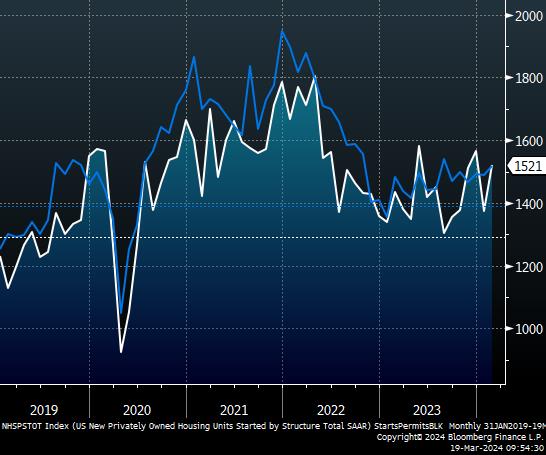Macro Flash Report
Takeaway:
The housing data released this week collectively indicate continued growth in the sector, driven by a shortage of existing homes inventory and downward pressure on mortgage rates. The substantial increase in construction activity points to strong structural demand that is likely to continue as financial conditions loosen.
Building Permits & Housing Starts

Preliminary February figures for Building Permits show a notable increase, rising by 1.9% to reach a seasonally adjusted annual rate of 1518k. This upswing surpassed the anticipated rise to 1500k from the prior month’s 1470k and reached the highest point since August 2023.
- The multi-family segment witnessed a significant 4.1% growth to 487k permits, while single-family home permits climbed 1.0% to 1031k – the peak since May 2022.
The Housing Starts data for February mark a significant rebound, increasing by 10.7% MoM to an annualized rate of 1521k. This surge comes after a -12.3% decline in January and exceeds the expected 1425k, highlighting a response to the ongoing shortage of previously owned homes.
- The single-family sector experienced an 11.6% rise to 1129k starts, while the multi-family units saw an 8.6% increase to 377k.
These two figures indicate a revitalizing and resilient housing market, with building permits signaling robust construction activity ahead and housing starts signaling a potential easing of the housing shortage.
NAHB Housing Market Index

The March NAHB Housing Market Index climbed to 51, showcasing the highest level of builder confidence in eight months and surpassing both the previous month’s rating of 48 and the market expected 48. This rise reflects a robust shift towards new home construction, spurred by a continuous shortage in existing home inventory and a rejuvenated demand triggered by falling mortgage rates from last fall’s peak.
- The index measuring current sales conditions jumped by 4 points to 56, sales expectations for the next six months increase by 2 point to 62, and the gauge for prospective buyer traffic rose by 2 points to 34.
NAHB Chief Economist Robert Dietz highlighted the anticipatory nature of the market, with expected Fed rate cuts in the latter half of 2024 poised to lower financing costs and attract more buyers. However, he cautioned that the surge in home building activity might confront builders with rising material costs,
underscoring the complex dynamics at play in the housing market’s recovery and growth.


